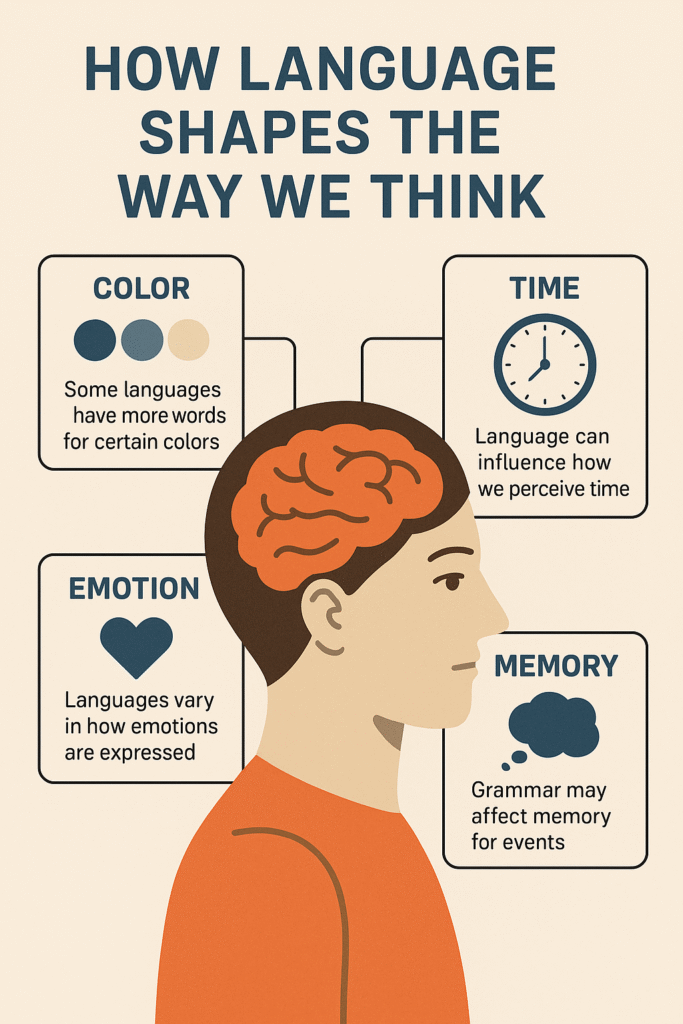Have you ever wondered if people who speak different languages actually think differently?
It’s not just about grammar or vocabulary — language shapes how we see the world, process ideas, and even feel emotions. From color perception to time travel (in our minds), the way we speak is deeply connected to how we think.
Let’s explore how the language we use can literally rewire our brains — and influence how we understand life itself.
1. Different Languages, Different Realities
In English, we might say, “The glass broke.”
In Spanish or Japanese, a speaker might say, “The glass broke itself” — focusing less on who did it.
Researchers found that English speakers are more likely to remember who caused an accident, while speakers of other languages focus more on the event itself.
📌 Language shapes blame, memory, and even justice.
2. Colors Don’t Always Mean the Same Thing
In Russian, there are different words for light blue (голубой) and dark blue (синий) — so Russian speakers are faster at distinguishing shades of blue.
In the Himba tribe of Namibia, there’s no word for “blue” at all — and they reportedly struggle to distinguish it from green.
🎨 What you call a color can affect whether you even see it.
3. Time Flows Differently in Different Languages
English speakers usually describe time as moving left to right (like on a timeline).
But people in Mandarin may also describe time vertically — with the past as “up” and the future as “down.”
And speakers of the Kuuk Thaayorre language in Australia describe time based on cardinal directions — east to west — regardless of which way they’re facing.
🕰️ So, to them, time doesn’t go forward — it moves through the land.

4. Gendered Languages Change Object Perception
Languages like Spanish, German, or French assign genders to nouns. That can shape how people think about those objects.
- In Spanish, the word for “bridge” (puente) is masculine → often described as strong or sturdy.
- In German, “bridge” (Brücke) is feminine → often described as beautiful or elegant.
👓 Even something as simple as grammar can shape emotion and description.
5. Language Affects Memory and Attention
Studies show bilingual people can switch between different worldviews just by switching languages.
- When speaking in English, they may focus on individual actions.
- When switching to their native language, they may pay more attention to social relationships and group dynamics.
🧠 Your mental lens changes with your words.
6. Some Languages Have No Words for Numbers or Directions
The Pirahã people in the Amazon don’t use words for exact numbers. Instead of “one, two, three,” they say something closer to “a few” or “many.”
Similarly, some languages don’t use left or right — only cardinal directions like north or east.
📍 So instead of saying “your left hand,” they’d say “your southwest hand.”
(Imagine how spatially aware you’d be if you had to think like that!)
7. You Feel Emotions Differently Based on Language
Language doesn’t just describe emotions — it can shape how intensely we feel them.
For example, people who speak multiple languages often say they feel less emotional when expressing something in a second language.
This has been used in therapy — switching languages can help people process trauma with a bit of emotional distance.
❤️ Language can help regulate how we feel.
8. It Changes How You Describe Yourself
Some languages emphasize action (“I failed the test”), while others emphasize state (“The test was failed”).
This subtle difference can change how people assign responsibility, self-worth, and motivation.
🌍 Your inner dialogue — and how hard or gently you judge yourself — may depend on your native tongue.
🧠 Final Thoughts: Does Language Shape Thought?
Yes — and no.
Most researchers agree: while thought comes first, the language you speak influences what you notice, how you describe it, and how you react to the world.
So, the more languages you know, the more perspectives you gain.
It’s like having multiple mental maps of reality — and switching between them opens up a richer, more flexible way of thinking.
Try this:
Describe something simple (like “a chair”) in two different languages. Notice what changes? That’s not just translation — that’s your brain seeing differently.